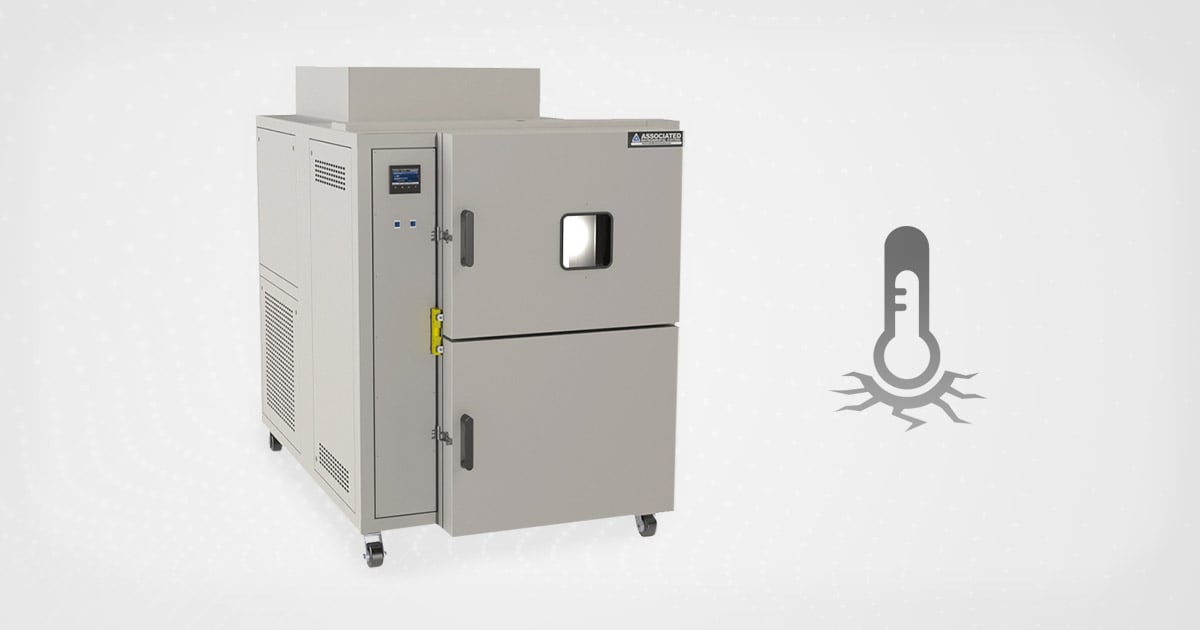What Is Thermal Shock Testing?

How do companies know whether their devices can withstand radical temperature changes and still function properly? Would you fly a plane if you weren’t confident all its components were sufficiently tested against extreme thermal conditions beforehand?
Thermal shock testing is the process through which a product is quickly transferred between two extreme temperatures to gauge its durability and identify potential breaking points.
This testing is meant to mimic, in an accelerated environment, the wear and tear a product will encounter in usual conditions or standard use. These sudden shifts in temperature can cause physical elements to shatter, crack, or bind in unintended ways.
Here’s what you need to know.
How Does Thermal Shock Testing Work?
To accomplish a rapid change in temperature, the device under testing (DUT) rests inside a basket that automatically moves between hot and cold zones within seconds. The temperature of these zones can be managed by either an air-to-air or liquid-to-liquid system.
While air is more standard, the alternative involves injecting liquid nitrogen (LN2) or carbon dioxide (CO2) into the test chamber to expand achievable temperature ranges and increase the temperature change rates. This is sometimes called a “liquid boost.” A LN2 boost can rapidly lower the temperature to -185°C (-300°F), while CO2 can lower the chamber's internal temperature almost instantaneously to -73°C (-100°F).
As many components that undergo temperature shock testing are utilized in aerospace and defense industries, there are a few common standards to ensure DUTs are rigorously tested: MIL-STD 883K Method 1010.9, MIL-STD 202H Method 107, MIL-STD-202G, and MIL-STD-883G.
What Industries Conduct Thermal Shock Testing?
Thermal shock testing is a great tool for determining the resilience of electronic, electromechanical, plastic, and mechanical products that will be deployed in the medical, consumer, aerospace, defense, or automotive industries (think of starting a car in the winter).
Consider the temperature variations the parts of an airplane experience as temperatures change as altitude increases or decreases, or the trauma inflicted on a GPS device used in wilderness terrain by field researchers. The ability of these electronics to function properly is often a matter of life and death.
About Thermal Shock Chambers
You could conduct thermal testing using multiple chambers. Say you have two temperature chambers. So long as they’re close to each other—for example, if they were stackable models—you could condition one to reach the extreme heat level and the other the extreme cold, then transfer the DUT between each.
However, there are chambers designed specifically for thermal shock testing—and you should strongly consider this option. The aforementioned military standards are exact. If you deviate at any point from the specifications, for even a minute, you’ll have to explain the deviation and how you compensated for it.
That isn’t an issue with a chamber optimized for thermal shock testing.
The best modern thermal shock chambers employ heavy-gauge steel exteriors and stainless steel interiors with a layer of highly efficient, low K-factor, thermal insulation to maintain high efficiency and temperature performance.
These chambers feature two zones, one maintaining a cooling zone while the other holds a heating zone.
The cooling zone includes a standard cascade refrigeration system typically designed with speedy recovery rates. Air cooling is less efficient but costs less while liquid-cooling options are a bit more complex, more efficient, and more expensive.
The heating zone is all-electric and consists of low-watt-density resistance heaters with ceramic cores. This extends their life, with limited downtime. Industry-leading chambers can support temperatures up to 220°C (428°F), with heaters operating independently for highly responsive temperature control.
Some models even offer a third zone between these two extremes if your testing calls for an ambient phase. The DUT moves between the chambers in a pneumatically controlled basket, containing its own sensor so engineers can monitor the product in addition to the temperature in each zone. Temperature data is collected often throughout testing in all three areas ensuring accurate recovery times.
All this combines for a reliable and precise process that ensures the most essential electronic-based products encountered in modern life are safe and durable not only for aerospace and defense industries but also for the general public.


